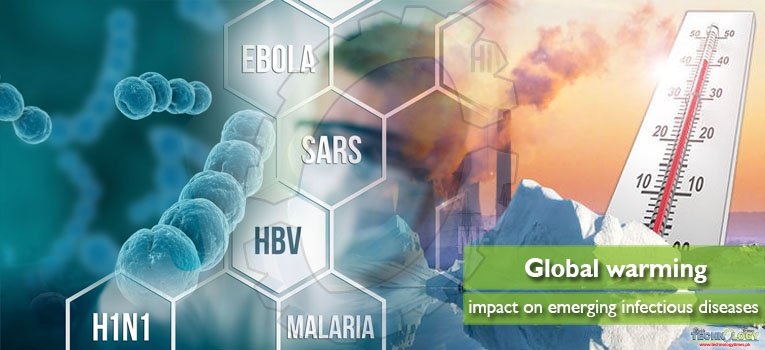The global warming leads to rise in sea levels, expansion of deserts in tropical and sub-tropical regions and most importantly, increases the risk of diseases in both humans and animals.

Since the earth has come into existence, the temperature has imparted an important role in the existence and beginning of life on this planet. In initial times, the persistence of life was impossible due to very high temperature. The earth history depicts that the temperature decreased gradually and life came into existence from simple forms like bacteria, viruses (prokaryotes) to more complex forms like humans (eukaryotes). Different forms of life exist in their suitable habitats and defined ecosystem.
The continuous but gradual increase in the temperature of earth surface is called global warming and it is increased with an average by 0.7 0C to 5.8 0C from 19th to 21st century. The greenhouse effect is an important phenomenon in global warming as it is due to the excessive production of greenhouse gases like carbon dioxide, nitrous oxide and methane. These gases have ability to absorb solar radiations and heat which cause increase in the temperature of earth surface leads to global warming.
The effects of global warming on the occurrence and transmission of infectious diseases in humans and animals can be reduced and prevented by different efforts like reduction in further emission of greenhouse gas, adaptation to new interventions, geo-engineering (recycling), advancement in modern studies etc.
The emission of greenhouse gases has increased due to excessive use of certain substances like fossil fuels, natural gas, coal, industrial wastes, agricultural fertilizers, anthropogenic activities and explosion of population. The global warming leads to rise in sea levels, expansion of deserts in tropical and sub-tropical regions and most importantly, increases the risk of diseases in both humans and animals.
There are various emerging diseases including vector borne diseases like Blue tongue, Japanese encephalitis, West Nile, Dengue and Hanta virus etc. The changes develop in habitats result in species extinction along with movement of pathogens including viruses, bacteria, arthropods (ticks) from one place to another place due to the transportation of livestock animals.
The climate changes like variations in temperature and humidity levels lead to excessive growth of bushy plants which ultimately cause increased rodent population and cause high risk of rodent borne infections like Leptospirosis and Plague etc.
The climate changes and vector borne diseases have many deleterious effects and these effects are categorized as direct and indirect effects. The direct effects are in the form of floods, famine, drought and extreme hot and cold weather conditions while indirect effects include outbreaks and changes in diseases transmission especially those diseases which are transmitted by different vectors and vehicles and effect the health of human and animals.
Reducing global warming effects on human and animal
The effects of climate changes specially global warming on the occurrence and transmission of infectious diseases in humans and animals can be reduced and prevented by different efforts like reduction in further emission of greenhouse gas, adaptation to new interventions, geo-engineering (recycling), advancement in modern studies. These studies includes biotechnology, molecular genetics and nanotechnology etc.
There is dire need to study vector control techniques, improved disease reporting, and better disease surveillance to enhance well investigation capacities and coordination between medical and veterinary institutes, researchers, administration, government personals and involvement of non-governmental organizations (NGOs). It is also important to include animal welfare organizations and international research bodies to overcome these zoonotic threats to human and animals.
In present scenario, it is depicted that within next few decades the environmental conditions may become more conducive for the growth and entry of unwanted harmful agents called pathogens in the biosphere. Hence it causes an urgent need to devise strategies involving techniques like satellite images and remote sensing to perform operative precautionary actions against different unpredicted outcomes because of continuously changing climatic conditions.
At last, the establishment of an ecologically justified society in terms of cooperation, equality, sustainability and participation indicates a proper solution of the global warming. This requires cooperation between all segments of society along with justified use of earth’s limited resources and controlled human population. All these things are only possible when development is made in biological and social systems that support nature and life by justified use of available resources.